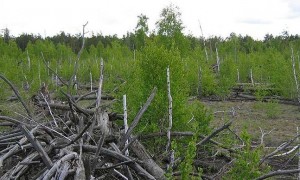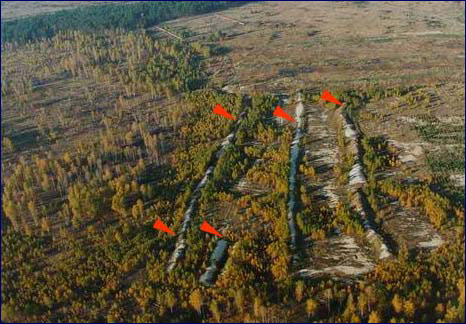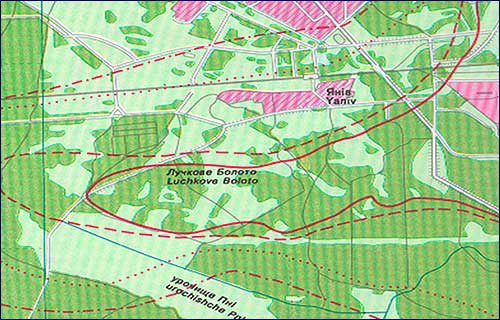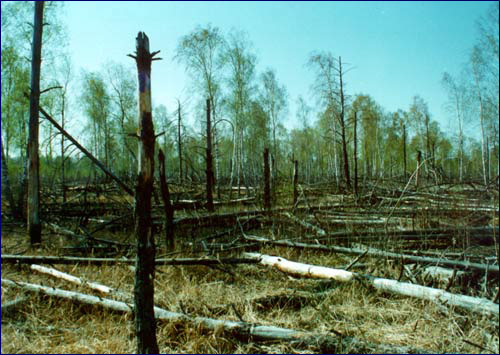

As a result of the Chernobyl accident, tens of thousands of hectares of forests have experienced massive radioactive contamination, located in the immediate vicinity of the Chernobyl NPP and stretching approximately two kilometers west of the station. These were mainly single-crop plantings of Scotch pine (Pinus silvestris). Signs of radioactive mutation of conifers are already evident, having absorbed approximately 100 doses. It should be noted that the main radiation fallout on the pines resulting from the Chernobyl accident occurred during the revitalization process of plant growth. In such a period the radiosensitivity of plants increases 1,5 – 3 times as compared to other periods. The crown of fairly dense pines acts as an effective filter, which helped delay the effects of large quantities of radioactive dust and aerosols in the crowns of these trees. Pine needles are typically not dropped for 2-3 years, causing a slow natural cleaning of crowns as compared with hardwood trees. This factor increased the radiation effects on coniferous trees compared to other breeds.
The aerial photos of death forest, named us Red forest in summer 1986.
/Materials of ISNPP RAS “Chernobyl in three dimensions”/.
Results of the radiation effect on pine forests were directly dependent on the amount of received radiation doses. Considering the nature of the radiation effects, scientists have classified four zones:
The first zone of Red Forest
Zone suffered a complete loss of conifers with partial damage to hardwoods (the so-called “Red forest”). Scholars estimate that the level of absorbed doses of external gamma radiation exposure in 1986-1987 was 8000 – 10000, with the maximum capacity of the external dose was 500 mR/h and more. This total area of this zone is approximately 400 hectares. In this zone, the pine tree trunks completely died and pine needles exhibited a brick color. The entire forest was virtually “burned down” – having accumulated a significant amount of radioactive emissions. Heavy radioactive contamination of the dead trees led to its burial. On the territory of the “Red Forest”, immediate actions were implemented to restore the forests. At 500 square hectares, the territory’s forest is already recovering.
The second zone of Red Forest
The zone of sublethal effects in the forests claimed the lives of 25-40% of the trees, and killed most of the forest underbrush (1-2,5 meters tall). In 90-95% of the trees and severely damaged die of young shoots and buds. Absorbed dose – 1000 – 8000 capacity exposure dose – 200 – 250 mR/h. This area of the zone encompassed 12500 hectares, including 3800 hectare of pine forests.
The third zone
The zone of average radiation damage of pine forest. This zone was affected in the characteristics of mostly young shoots and pine needles turned yellow only on separate sites of branches. Small morphological deviations in the growth of pines were also noted, but these plants have maintained their viability. The absorbed dose 400 – 500 and capacity exposure does 50 – 200 mR/h. The area of the third zone encompassed 43300 hectares, including 11900 hectare of pine forests.
The fourth zone
The zone of weak effects where some growth process anomalies were seen. Visible damage of the pines has not been found. All trees have maintained normal growth and needle colour. Absorbed dose was 50-120 capacity exposure dose – 20 mR/h.
Configuration of the zones of forest destruction by radioactive emissions is displayed in the maps below. Zoning of the stricken forests was completed in 1987 and these areas have changed over time, through the process of natural vegetation recovery (1991).
Map of the zoning of the dead forests (“Red Forest”), which was created due to the spread of radioactive fallout (as of spring 1987).
Damaged trees have been observed in violation of the natural rhythm of growth processes, targeting shoots and morphological processes. Doses of 300 – 400 caused growth in the diameter of birch, spruce and pine trunks to decrease by half.
Together, the affected trees have been observed to have active regenerative processes. For example, in forming gigantic spruce pine needles up to 4 – 4,5 cm and in the pines – 12 – 14 cm. From 1989-1992, the amount of needles on young shoots increased by 3 – 3,5 times compared to 1986. Germination of seeds has increased. This fact indicates an increase in reproductive functions among species.
The combination of research results makes it possible to predict the subsequent development of restoration processes. In the zones of average and sublethal effects, natural rehabilitation (recovery) of the forest will occur. In the place of pine forests will develop mainly deciduous plantings, with a predominance of birch and shrub species of plants. Gradual turfing of the soil will also occur.
Dead trees were a significant risk of, for example by fire, a secondary source of radioactive contamination. Moreover, radiation from dead trees significantly deteriorated the situation near the road that was one of the major transportation hubs of the Chernobyl nuclear power plant.
Different methods were suggested for the decontamination of the territory of the Red Forest. Even before the discussions about decontamination methods ended in 1987, trenches 2.5 meters in height and approximately 3.5 km in length were dug around the dead trees. The burial of the dead trees, forest undergrowth and topsoil was accomplished through the use of felling, shovel dumped trees by bulldozers, put it the remains into the trenches and covering them with a one meter thick layer of soil. In total, more than four thousand cubic meters of radioactive materials were buried. As a result of these activities, the capacity exposure dose of gamma radiation has decreased in 4 – 50 times, and in the second half of 1987 (after decontamination works), the maximum levels of the dose rate amounted to 180 mR/h.

Aerial view overlooking the burial trenches with radioactive trees – Red Forest (trenches indicated by arrows).
Burial of radioactive trees occurred in deep trenches – 0,5 – 2 meters deep. This is at the level of local groundwater. This has led to the contamination of groundwater by the accidental release of radioactive substances. According to scientists, already 2 – 3 years after burial, the existence of radionuclides was noted in the groundwater near the trenches where dead trees were buried.
Currently, the burial place of the dead forest is a source of radioactive substances in the groundwater, which qualifies as long-term contamination. Because of the negative environmental impact of such an event, as well as the complexity of its removal (minimize), one can conclude that the burial of the dead trees was not a good plan, but only deepened the environmental problems.

Restoring forest plots in the Red Forest (based on ChSCIR data, 1999)
Reference about Red Forest:
- Chernobyl disaster and its aftermath: Information prepared for the meeting of IAEA experts – Part 1. The compilation. August 1986.
- Chernobyl: the radioactive contamination of natural environments / Ed. Yuri A. Izrael. Leningrad: Gidrometeoizdat, 1990.
- Tikhomirov F.A. Shchleglov A.I. Radiological consequences of the Kyschtyme and Chernobyl radiation accident in forest ecosystems. Ecology regions of nuclear power plants. Vol 1, 1994. – P. 71-88.





